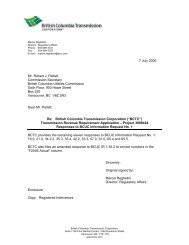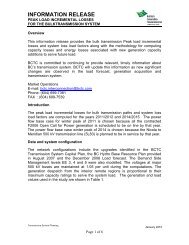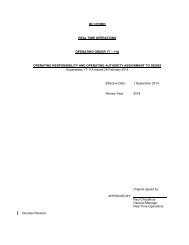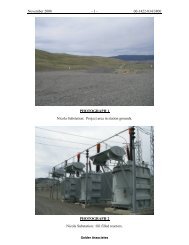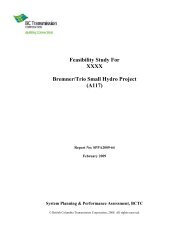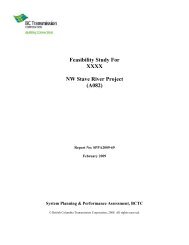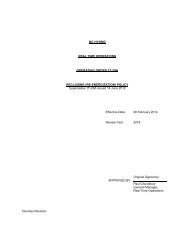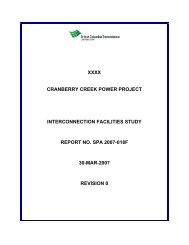Evidence on the Adequacy of First Nations Consultation - BC Hydro ...
Evidence on the Adequacy of First Nations Consultation - BC Hydro ...
Evidence on the Adequacy of First Nations Consultation - BC Hydro ...
You also want an ePaper? Increase the reach of your titles
YUMPU automatically turns print PDFs into web optimized ePapers that Google loves.
The Inissimi Complex was defined for this time period to encompass a distinctive set <strong>of</strong> artefact<br />
assemblages <strong>on</strong> <strong>the</strong> Kootenay river and its major tributaries, from <strong>the</strong> big bend in northwestern M<strong>on</strong>tana<br />
at least as far downstream as <strong>the</strong> north arm <strong>of</strong> Kootenay lake…Characteristic features <strong>of</strong> <strong>the</strong> Inissimi<br />
Complex are predominance <strong>of</strong> Kootenay Argillite and a distinctive form <strong>of</strong> projectile point not found in<br />
surrounding regi<strong>on</strong>s that has an expanding stem, a ground c<strong>on</strong>vex base, and acute to right-angled<br />
shoulders…<br />
The abundance and distributi<strong>on</strong> <strong>of</strong> Kootenay Argillite in Inissimi Complex sites al<strong>on</strong>g Kootenay Lake<br />
and <strong>the</strong> Kootenay River as far upstream as Libby, M<strong>on</strong>tana has been interpreted to reflect <strong>the</strong> use <strong>of</strong><br />
canoes. The seas<strong>on</strong>al round is hypo<strong>the</strong>sized to have comprised wintering near <strong>the</strong> important deer winter<br />
ranges at <strong>the</strong> south end <strong>of</strong> <strong>the</strong> Purcell Mountains and a summer focus <strong>on</strong> <strong>the</strong> salm<strong>on</strong> fishery al<strong>on</strong>g <strong>the</strong><br />
lower Kootenay River. Prior to <strong>the</strong> return to <strong>the</strong> wintering area, a northward swing was made to obtain<br />
st<strong>on</strong>e from quarries above <strong>the</strong> North Arm <strong>of</strong> <strong>the</strong> Kootenay and to hunt deer <strong>on</strong> <strong>the</strong> east side <strong>of</strong> <strong>the</strong> lake.<br />
Were <strong>the</strong>se Indians <strong>the</strong> ancestors <strong>of</strong> modern Ktunaxa? An archaeological discovery in Alberta<br />
appears to cement <strong>the</strong>se ancient argillite sites with <strong>the</strong> uniquely Ktunaxan mode <strong>of</strong> life <strong>of</strong> fishing <strong>on</strong><br />
waterways <strong>of</strong> <strong>the</strong> Kootenays and hunting east <strong>of</strong> <strong>the</strong> Rockies. The archaeologist Brian Reeves wrote<br />
<strong>of</strong> his work <strong>on</strong> <strong>the</strong> 2000 year old “Pelican Lake” phase <strong>of</strong> <strong>the</strong> famous site <strong>of</strong> Head-Smashed-In-<br />
Buffalo-Jump: 11<br />
Some <strong>of</strong> <strong>the</strong> projectile points from <strong>the</strong> Pelican Lake strata have stems ra<strong>the</strong>r than being notched at <strong>the</strong><br />
corners. These too were made from an exotic raw material: metamorphosed argillite from <strong>the</strong> Kootenay<br />
Lake area <strong>of</strong> British Columbia some 800 kilometers west <strong>of</strong> Head-Smashed-In. Both <strong>the</strong>ir source and<br />
<strong>the</strong>ir alien shape suggest that visitors from Kootenay Lake occasi<strong>on</strong>ally participated in <strong>the</strong> Pelican Lake<br />
people’s buffalo drives…<br />
For his part, Choquette and his colleagues have been following <strong>the</strong> distributi<strong>on</strong> <strong>of</strong> a chert originally<br />
quarried at a site called Top <strong>of</strong> <strong>the</strong> World in <strong>the</strong> Canadian Rockies. This hard st<strong>on</strong>e was highly prized<br />
for tool making and has been found throughout and bey<strong>on</strong>d <strong>the</strong> Ktunaxa range, in British Columbia,<br />
Washingt<strong>on</strong>, M<strong>on</strong>tana and Idaho.<br />
The first scientific archaeological investigati<strong>on</strong> in <strong>the</strong> study area may have been carried out in 1954,<br />
when an archaeological team led by Charles Borden <strong>of</strong> <strong>the</strong> University <strong>of</strong> British Columbia performed<br />
over 50 site surveys in <strong>the</strong> Upper Columbia stretching from Lake Windermere to <strong>the</strong> U.S. border. 12<br />
In a gradient increasing towards <strong>the</strong> south end <strong>of</strong> this range, his team uncovered large numbers <strong>of</strong><br />
expanded stem points characteristic <strong>of</strong> <strong>the</strong> Ktunaxa, many <strong>of</strong> which were encrusted by a patina<br />
created by centuries <strong>of</strong> being subjected to <strong>the</strong> elements. As <strong>the</strong>y moved northward to Columbia<br />
Lakes <strong>the</strong>y encountered more side-notched points which were thought to be more characteristic <strong>of</strong><br />
Interior Salish and c<strong>on</strong>cluded <strong>the</strong>y were probably left by <strong>the</strong> Kinbasket people. Remains <strong>of</strong> what were<br />
identified as Salishan pit houses were also found in <strong>the</strong> vicinity <strong>of</strong> Columbia and Windermere Lakes,<br />
leading Borden to c<strong>on</strong>clude that <strong>the</strong> sou<strong>the</strong>rn range <strong>of</strong> <strong>the</strong> Kinbasket Shuswaps may have at <strong>on</strong>e time<br />
included all <strong>of</strong> Columbia Lake. Unlike many <strong>of</strong> <strong>the</strong> expanded stem points, <strong>the</strong> side-notch points<br />
appeared to have had virtually no patina <strong>of</strong> aging, attesting to relatively recent depositi<strong>on</strong>. 13<br />
However subsequent excavati<strong>on</strong>s have called into questi<strong>on</strong> some <strong>of</strong> <strong>the</strong> c<strong>on</strong>clusi<strong>on</strong>s <strong>of</strong> Borden’s team<br />
11 From Scientific American, October, 1983, from Weir, p. 9.<br />
12 Borden, Charles 1956, pp. 73-104,<br />
13 In more recent research, Wayne Choquette has argued that <strong>the</strong> Ktunaxa also appear to have used side-notch points, thus<br />
disputing an orthodoxy that has usually attributed this style to n<strong>on</strong>-Ktunaxa people. At <strong>the</strong> least, <strong>the</strong> c<strong>on</strong>clusi<strong>on</strong>s <strong>of</strong><br />
Borden’s team should be viewed with some cauti<strong>on</strong><br />
9<br />
Page 153 <strong>of</strong> 200






